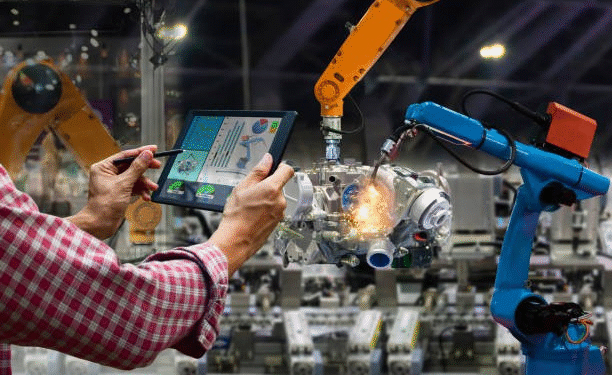Manufacturing is one of the most important industries of our time. If you are a manufacturer, you might be well-versed in the challenges of the industry. If not navigated effectively, the ever-changing landscape poses a risk to manufacturers. Productivity is the key to unlocking maximum potential in manufacturing. Changing times call for smart planning and strategizing. Automation, material handling, and workforce strategies help manufacturers maximize productivity. The synergy between technology and the human workforce will etch success stories for manufacturers in the coming years. In this article, we discuss different ways to increase productivity in manufacturing. Please read until the end to make an informed decision.
1. Optimize Facility Layout
One of the best things you can do is create clear workflow paths. Any hindrance to the movement of goods and people is undesirable. Work with a designer to create a layout ideal for your manufacturing facility. Consider having dedicated zones for loading, storing, and unloading.
A thoughtfully designed layout improves productivity by avoiding unnecessary collisions and accidents. Reducing unnecessary movement of materials is also important to enhance productivity. The goal is to meet production goals while minimizing material and workforce movement. Despite all the effort, some things can only be figured out with trial and error. So, being patient is important.
2. Implement Lean Manufacturing Principles
Lean manufacturing principles focus on minimizing wastage and maximizing productivity. As a manufacturer, you must avoid downtimes at all costs. Since time is money, downtime means unnecessary expenses and lower profits. You can ensure uninterrupted operations by ensuring equipment maintenance, workforce availability, and appropriate raw material sourcing.
The focus must also be on minimizing wastage. Standardize workflow to ensure maximum efficiency and eliminate wastage. Waste management is a huge expense that most manufacturers do not account for. If not limited, waste management can eat into your budget and efficiency.
3. Automate Material Handling Processes
Conveyor systems are an inextricable element of material handling at manufacturing facilities. They help achieve optimal material handling time, thus enhancing productivity. Gravity conveyors provide a cost-effective solution for seamless product flow without the need for motorized transport. Effective conveyor systems reduce workload on your employees, allowing them to focus their energy on more important tasks. Gravity conveyors are cost-effective and durable.

You must also enhance lifting capabilities to boost productivity at manufacturing facilities. Without the right equipment, lifting loads in confined spaces is immensely challenging. Mini cranes offer a compact, mobile, and precise lifting solution, improving workflow speed and safety. From vertical warehouses to loading areas, mini cranes are increasingly helpful. Automate material handling processes with gravity conveyors and mini cranes to boost productivity. Do not forget to train employees to operate material handling systems efficiently. This brings us to the next point.
4. Invest in Employee Training and Upskilling
Change is the only constant. Your workforce must adapt to changing times to stay relevant and maximize productivity. Invest in employee training and upskilling to encourage continuous improvement.
Conduct workshops and hands-on training for equipment usage. A synergy between equipment and workforce is crucial to boost efficiency. Employees can be trained in fixed intervals or when new equipment is installed at the facility.
Many industrial equipment manufacturers offer turnkey support. Working with such companies will take the load off your shoulders in terms of employee training. A well-trained, knowledgeable workforce is crucial for optimal efficiency in the long run.
5. Improve Communication and Collaboration
No business can thrive without effective communication and collaboration. Synergy is the key to enhanced productivity. Uninterrupted cross-departmental communication must be encouraged to enhance efficiency.
Digital communication tools make things easier for medium and large-scale manufacturing facilities. They prove helpful in scenarios where in-person meetings are difficult due to conflicting schedules. Digital communication tools also help keep relevant stakeholders in the loop.
6. Predictive Maintenance For Equipment
A manufacturing facility cannot sustain itself without top-notch equipment. They need to be in optimal condition to offer unmatched performance. It is important to understand that even the best tools and equipment require maintenance for uninterrupted operations.
Predictive maintenance can prevent unexpected downtimes. Sensors, monitoring systems, and Iot are all useful for detecting problems in advance and facilitating predictive maintenance. Remember, maintenance is better than lengthy, expensive repairs.
7. Optimize Inventory Management
Inventory is the most crucial aspect determining a manufacturing facility’s productivity. For enhanced productivity, manufacturing facilities must focus on inventory management. Overstocking and stockouts are both problems with detrimental effects. When you overstock inventory, you maximize the risk of loss. Too many raw materials and finished products lying around can lead to wastage.
Not to mention the increased expenditure that all this will lead to. On the other hand, stockouts mean you fail to meet production targets. Stockouts are a result of poor planning, tracking, and inventory management. Use automated tracking solutions to ensure optimal inventory levels. Automated inventory management systems help track raw materials, work-in-progress, and finished products. With real-time inventory tracking, you will never face problems again.
8. Leverage Data and Analytics For Performance Tracking
Data is more than just a buzzword. It helps you track performance and overcome production bottlenecks. You must leverage data and analytics to make favourable business decisions. Set measurable KPIs to ensure targets are met every quarter. You can work with data analytics experts to make sense of big data.
Data collection is done through sensors, monitors, and advanced software systems. Thanks to AI, ML, and Iot, collecting data is now easier than ever. Different equipment in the manufacturing facility communicates with each other. All of which can be studied to understand factors like average processing time, work quality, efficiency, etc.
Conclusion
Increasing productivity in manufacturing doesn’t have to be difficult. The simple tips listed in this blog help manufacturers enhance productivity. Automated material handling systems like gravity conveyors and mini cranes are crucial for manufacturing facilities.
Only by enhancing material handling can manufacturing processes be sped up and made more efficient. Moreover, leveraging data and analytics for performance tracking can help you plug production bottlenecks. Through careful planning and seamless execution, you can maximize profits in your manufacturing business.












